HP ProBook 450 G9 review – a fantastic balance between price and features
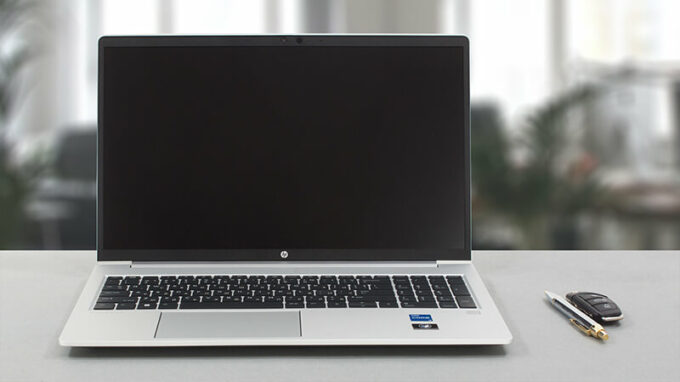 Imagine it is your first day on a new job, and they tell you that you need to pick your own business laptop on their treat. But the budget is not very big. What would you pick? A ProBook 450 G9 is definitely one of the options you need to consider.
Imagine it is your first day on a new job, and they tell you that you need to pick your own business laptop on their treat. But the budget is not very big. What would you pick? A ProBook 450 G9 is definitely one of the options you need to consider.
Other viable choices would be the Lenovo ThinkPad E15 Gen 4, or even the HP EliteBook 650 G9. In fact, there is very little separating the EliteBook 650 G9 from the ProBook 450 G9. Some of you might argue that one of them was created to boost the sales of the other.
There is no way of knowing for certain. However, what we do know is that you can pick the ProBook 450 G9 with Intel’s Alder Lake processors – either from the U-series or the P-series.
Unfortunately, you have to skip the base screen option, as it only has a 768p resolution and a TN panel. Nevertheless, you can pick your device with a 1080p IPS unit with full sRGB color gamut support, should you need it for color-related work.
You can check the prices and configurations in our Specs System: https://laptopmedia.com/series/hp-probook-450-g9/
Contents
Specs Sheet
- HDD/SSD
- up to 4000GB SSD
- M.2 Slot
- 1x 2280 M.2 PCIe + 1x 2230 M.2 PCIe See photo
- RAM
- up to 64GB
- OS
- Windows 11 Pro, Windows 10 Pro, Windows 11 Home, Windows 10 Home
- Battery
- 51.3Wh, 3-cell, 42.75Wh, 3-cell, 51Wh, 3-cell, 42.75Wh, 3-cell
- Body material
- Aluminum
- Dimensions
- 359.4 x 233.9 x 19.9 mm (14.15" x 9.21" x 0.78")
- Weight
- 1.74 kg (3.8 lbs)
- Ports and connectivity
- 1x USB Type-A
- 3.2 Gen 1 (5 Gbps), Sleep and Charge
- 2x USB Type-A
- 3.2 Gen 1 (5 Gbps)
- 1x USB Type-C
- 3.2 Gen 2 (10 Gbps), Power Delivery (PD), DisplayPort
- HDMI
- 2.1
- Card reader
- Ethernet LAN
- 10, 100, 1000 Mbit/s
- Wi-Fi
- 802.11ax
- Bluetooth
- 5.2
- Audio jack
- 3.5mm Combo Jack
- Features
- Fingerprint reader
- optional
- Web camera
- HD
- Backlit keyboard
- optional
- Speakers
- 2x Stereo Speakers
- Optical drive
- Security Lock slot
- Nano K-Lock
All HP ProBook 450 G9 configurations
What’s in the box?
Inside the package, we found the mandatory paperwork, as well as a 65W USB Type-C charger.
Design and construction
The HP ProBook 450 G9 is an all-aluminum laptop, which weighs from 1.74 to 1.79 kg and has a profile of 19.9mm. This makes it both reasonably thin and light, which is great for a notebook of its class.
Furthermore, we observed a pretty good structural rigidity. Yes, the lid shows some flex, but the base is sturdy enough for you not to be worried.
Surprisingly or not, the lid can be opened with a single hand. This reveals super slim bezels around the matte display. Moreover, the top one houses an HD Web camera with a privacy shutter, and an optional IR face recognition scanner beside it.
Down at the base, we see the spill-resistant, backlit keyboard. It features a NumberPad and has good key travel. In addition, its feedback is clicky, which results in a very comfortable typing experience.
As you can see, there is a large grill above the keyboard. It houses the two speakers, while the small square cutout on the bottom right is the fingerprint reader. In the middle, but a bit centered to the left, you will find the touchpad. It is a smooth unit with decent response time and super-accurate tracking.
Turn the machine upside down, and you will get a look at the ventilation grill. Hot air, respectively, gets exhausted through a vent in between the base and the lid.
Ports
On the left side, there is a security lock slot, a LAN port, and a USB Type-A 3.2 (Gen. 1) port. On the right, you get a power plug, a USB Type-C 3.2 (Gen. 2) port with Power Delivery and a DisplayPort function, two USB Type-A 3.2 (Gen. 1) ports, an HDMI 2.1 connector, an Audio jack, and an optional SIM card tray.
Disassembly, upgrade options, and maintenance
To get inside this notebook, you need to undo a total of 5 Phillips-head screws, three of which are captive. Then, pry the bottom panel with a plastic tool, and remove it from the chassis.
Here, we get a 51.3Wh battery pack. It got us through 12 hours of Web browsing, or 8 hours and 30 minutes of video playback. To remove it, unplug the battery from the motherboard, and remove all 6 Phillips-head screws.
Memory-wise, there are two SODIMM slots, which fit DDR4 RAM and work in dual-channel mode. As for the storage, there are two M.2 PCIe slots. However, one of them can be only used if there is no LTE card installed.
The cooling here comes with two heat pipes, a heat sink, and one fan. You can also spot a couple of heat spreaders for the graphics memory and the VRMs.
Display quality
HP ProBook 450 G9 has a Full HD IPS panel with a model number LG LGD071E. Its diagonal is 15.6″ (39.62 cm), and the resolution is 1920 х 1080 pixels. The screen ratio is 16:9, and we are looking at a pixel density of – 142 ppi, and a pitch of 0.18 х 0.18 mm. The screen turns into Retina when viewed at a distance equal to or greater than 60cm (24″) (from this distance one’s eye stops differentiating the separate pixels, and it is normal for looking at a laptop).
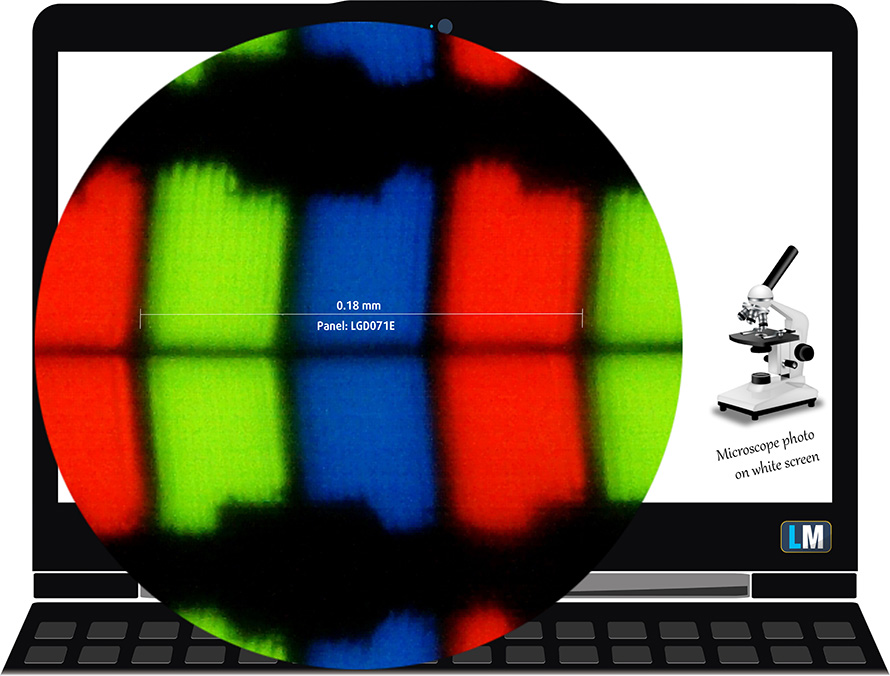
Viewing angles are comfortable. We offer images at 45° to evaluate image quality.

Also, a video with locked focus and exposure.
The measured maximum brightness of 246 nits in the middle of the screen and 263 nits as an average for the whole area, with a maximum deviation of 9%. The Correlated Color Temperature on a white screen is 6180K – slightly warmer than the sRGB standard of 6500K, which is great.
In the illustration below you can see how the display performs from a uniformity perspective. In other words, the leakage of light from the light source.
Values of dE2000 over 4.0 should not occur, and this parameter is one of the first you should check if you intend to use the laptop for color-sensitive work. The contrast ratio is good – 1170:1.
To make sure we are on the same page, we would like to give you a little introduction to the sRGB color gamut and the Adobe RGB. To start, there’s the CIE 1976 Uniform Chromaticity Diagram that represents the visible specter of colors by the human eye, giving you a better perception of the color gamut coverage and the color accuracy.
Inside the black triangle, you will see the standard color gamut (sRGB) that is being used by millions of people on HDTV and on the web. As for the Adobe RGB, this is used in professional cameras, monitors, etc for printing. Basically, colors inside the black triangle are used by everyone and this is the essential part of the color quality and color accuracy of a mainstream notebook.
Still, we’ve included other color spaces like the famous DCI-P3 standard used by movie studios, as well as the digital UHD Rec.2020 standard. Rec.2020, however, is still a thing of the future and it’s difficult for today’s displays to cover that well. We’ve also included the so-called Michael Pointer gamut, or Pointer’s gamut, which represents the colors that naturally occur around us every day.
The yellow dotted line shows HP ProBook 450 G9’s color gamut coverage.
Its display covers 51% of the sRGB/ITU-R BT.709 (web/HDTV standard) in CIE1976.

Our “Design and Gaming” profile delivers optimal color temperature (6500K) at 140 cd/m2 luminance and sRGB gamma mode.
We tested the accuracy of the display with 24 commonly used colors like light and dark human skin, blue sky, green grass, orange, etc. You can check out the results in factory condition and also, with the “Design and Gaming” profile.
Below you can compare the scores of the HP ProBook 450 G9 with the default settings (left), and with the “Gaming and Web design” profile (right).
The next figure shows how well the display is able to reproduce really dark parts of an image, which is essential when watching movies or playing games in low ambient light.
The left side of the image represents the display with stock settings, while the right one is with the “Gaming and Web Design” profile activated. On the horizontal axis, you will find the grayscale, and on the vertical axis – the luminance of the display. On the two graphs below you can easily check for yourself how your display handles the darkest nuances but keep in mind that this also depends on the settings of your current display, the calibration, the viewing angle, and the surrounding light conditions.
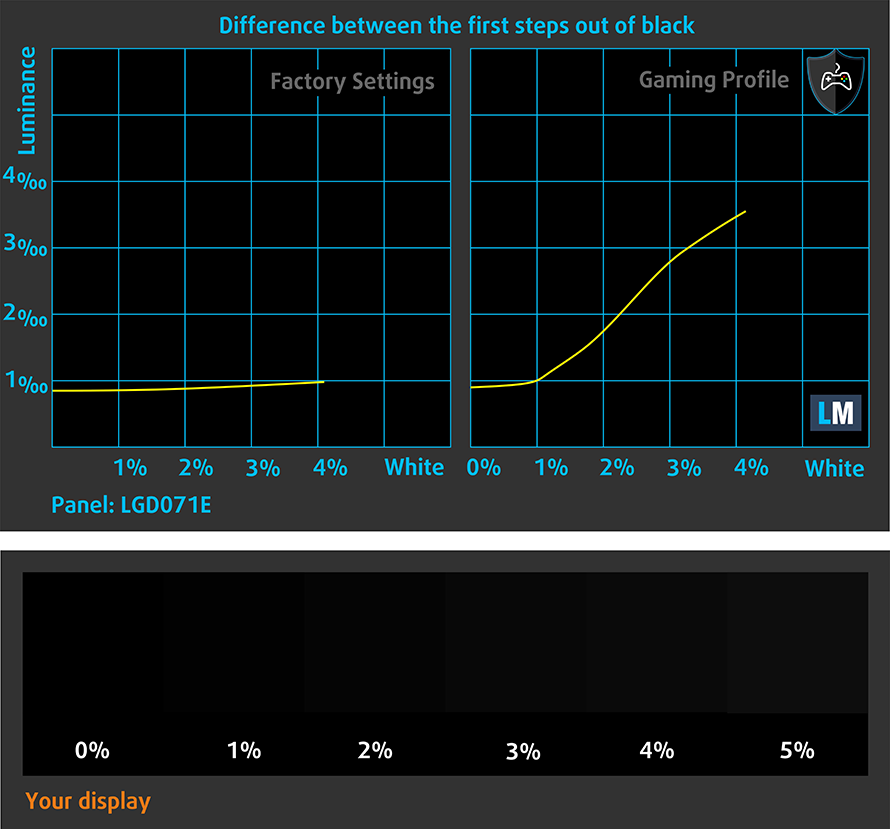
Response time (Gaming capabilities)
We test the reaction time of the pixels with the usual “black-to-white” and “white-to-black” method from 10% to 90% and vice versa.
We recorded Fall Time + Rise Time = 30 ms.
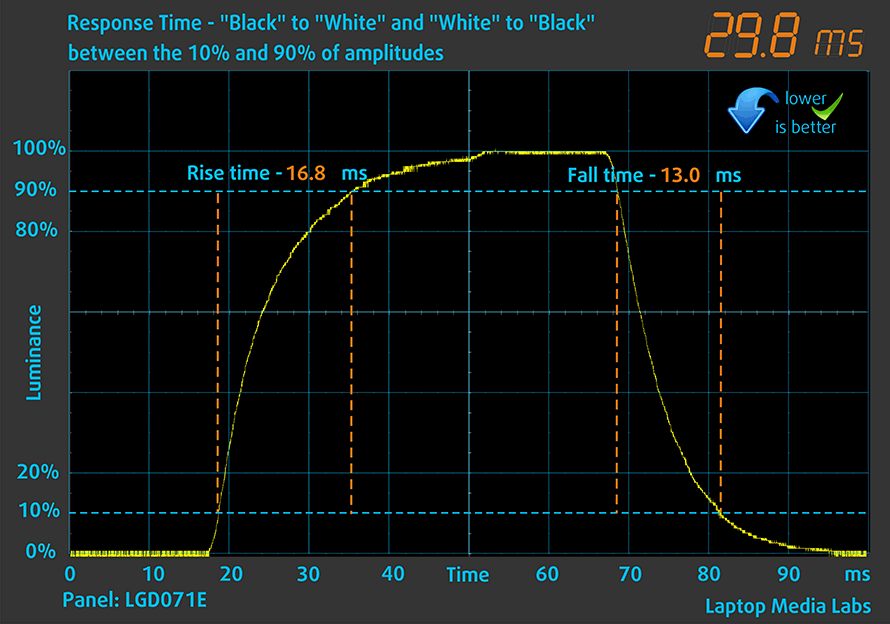
After that, we test the reaction time of the pixels with the usual “Gray-to-Gray” method from 50% White to 80% White and vice versa between 10% and 90% of the amplitude.

PWM (Screen flickering)
Pulse-width modulation (PWM) is an easy way to control monitor brightness. When you lower the brightness, the light intensity of the backlight is not lowered, but instead turned off and on by the electronics with a frequency indistinguishable to the human eye. In these light impulses, the light/no-light time ratio varies, while brightness remains unchanged, which is harmful to your eyes. You can read more about that in our dedicated article on PWM.
HP ProBook 450 G9’s display doesn’t use PWM at any brightness level. This makes it comfortable and safe in this aspect.
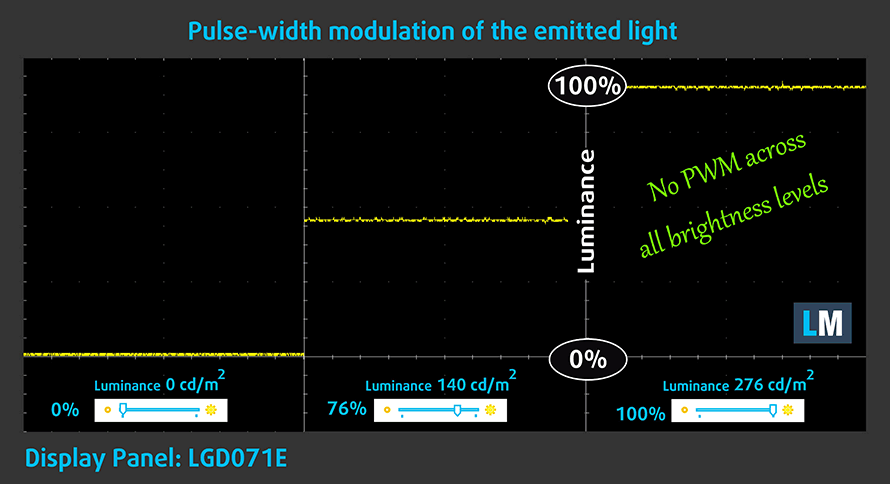
Blue light emissions
Installing our Health-Guard profile not only eliminates PWM but also reduces the harmful Blue Light emissions while keeping the colors of the screen perceptually accurate. If you’re not familiar with the Blue light, the TL;DR version is – emissions that negatively affect your eyes, skin, and your whole body. You can find more information about that in our dedicated article on Blue Light.
Gloss level measurement
Glossy-coated displays are sometimes inconvenient in high ambient light conditions. We show the level of reflection on the screen for the respective laptop when the display is turned off and the measurement angle is 60° (in this case, the result is 23.9 GU).

Buy our profiles
Since our profiles are tailored for each individual display model, this article and its respective profile package are meant for HP ProBook 450 G9 configurations with 15.6″ FHD IPS LG LGD071E.
*Should you have problems with downloading the purchased file, try using a different browser to open the link you’ll receive via e-mail. If the download target is a .php file instead of an archive, change the file extension to .zip or contact us at [email protected].
Read more about the profiles HERE.
In addition to receiving efficient and health-friendly profiles, by buying LaptopMedia's products you also support the development of our labs, where we test devices in order to produce the most objective reviews possible.

Office Work
Office Work should be used mostly by users who spend most of the time looking at pieces of text, tables or just surfing. This profile aims to deliver better distinctness and clarity by keeping a flat gamma curve (2.20), native color temperature and perceptually accurate colors.

Design and Gaming
This profile is aimed at designers who work with colors professionally, and for games and movies as well. Design and Gaming takes display panels to their limits, making them as accurate as possible in the sRGB IEC61966-2-1 standard for Web and HDTV, at white point D65.

Health-Guard
Health-Guard eliminates the harmful Pulse-Width Modulation (PWM) and reduces the negative Blue Light which affects our eyes and body. Since it’s custom tailored for every panel, it manages to keep the colors perceptually accurate. Health-Guard simulates paper so the pressure on the eyes is greatly reduced.
Get all 3 profiles with 33% discount
Sound
HP ProBook 450 G9’s speakers produce a sound of okay quality. Its low, mid, and high tones all have some deviations from clarity. Unfortunately, the speakers are a bit too quiet too.

Drivers
All drivers and utilities for this notebook can be found here: https://support.hp.com/us-en/drivers/selfservice/hp-probook-450-15.6-inch-g9-notebook-pc/2101000499
Battery
Now, we conduct the battery tests with the Windows Better performance setting turned on, screen brightness adjusted to 120 nits, and all other programs turned off except for the one we are testing the notebook with. Here, the 51.3Wh battery pack lasts for 12 hours and 13 minutes of Web browsing, or 8 hours and 28 minutes of video playback.
In order to simulate real-life conditions, we used our own script for automatic web browsing through over 70 websites.
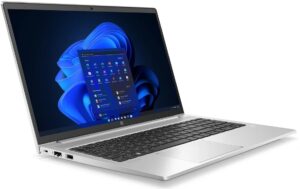
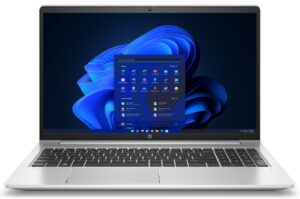

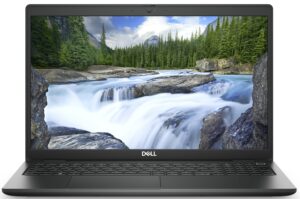
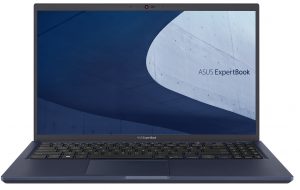

For every test like this, we use the same video in HD.






CPU options
This device can be found with the Celeron 7305, Pentium 8505, Core i3-1215U, Core i5-1235U, Core i7-1255U, Core i5-1240P, or the Core i7-1260P.
Results are from the Cinebench R23 CPU test (the higher the score, the better)
Results are from our Photoshop benchmark test (the lower the score, the better)
HP ProBook 450 G9 CPU variants
Here you can see an approximate comparison between the CPUs that can be found in the HP ProBook 450 G9 models on the market. This way you can decide for yourself which HP ProBook 450 G9 model is the best bang for your buck.
Note: The chart shows the cheapest different CPU configurations so you should check what the other specifications of these laptops are by clicking on the laptop’s name / CPU.
Results are from the Cinebench R23 CPU test (the higher the score, the better)
Results are from our Photoshop benchmark test (the lower the score, the better)
GPU options
Like the 14-inch version, you can get the laptop with an integrated GPU, or the NVIDIA GeForce MX570.
Results are from the 3DMark: Time Spy (Graphics) benchmark (higher the score, the better)
Results are from the 3DMark: Fire Strike (Graphics) benchmark (higher the score, the better)
Results are from the 3DMark: Wild Life benchmark (higher the score, the better)
Results are from the Unigine Superposition benchmark (higher the score, the better)
HP ProBook 450 G9 GPU variants
Here you can see an approximate comparison between the GPUs that can be found in the HP ProBook 450 G9 models on the market. This way you can decide for yourself which HP ProBook 450 G9 model is the best bang for your buck.
Note: The chart shows the cheapest different GPU configurations so you should check what the other specifications of these laptops are by clicking on the laptop’s name / GPU.
Results are from the 3DMark: Time Spy (Graphics) benchmark (higher the score, the better)
Results are from the 3DMark: Fire Strike (Graphics) benchmark (higher the score, the better)
Results are from the 3DMark: Wild Life (Graphics) benchmark (higher the score, the better)
Results are from the Unigine Superposition benchmark (higher the score, the better)
Gaming tests
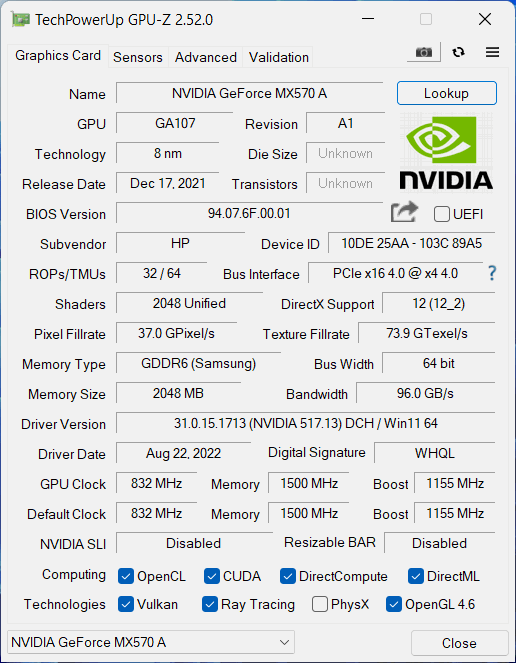

| CS:GO | HD 1080p, Low (Check settings) | HD 1080p, Medium (Check settings) | HD 1080p, MAX (Check settings) |
|---|---|---|---|
| Average FPS | 202 fps | 169 fps | 155 fps |

| DOTA 2 | HD 1080p, Low (Check settings) | HD 1080p, Normal (Check settings) | HD 1080p, High (Check settings) |
|---|---|---|---|
| Average FPS | 132 fps | 105 fps | 90 fps |
Temperatures and comfort
Max CPU load
In this test we use 100% on the CPU cores, monitoring their frequencies and chip temperature. The first column shows a computer’s reaction to a short load (2-10 seconds), the second column simulates a serious task (between 15 and 30 seconds), and the third column is a good indicator of how good the laptop is for long loads such as video rendering.
Average P-core frequency; Average E-core frequency; CPU temp.; Package Power
| Intel Core i5-1235U (15W TDP) | 0:02 – 0:10 sec | 0:15 – 0:30 sec | 10:00 – 15:00 min |
|---|---|---|---|
| HP ProBook 450 G9 | 3.44 GHz @ 2.82 GHz @ 80°C @ 47W | 2.45 GHz @ 2.14 GHz @ 74°C @ 26W | 2.33 GHz @ 2.09 GHz @ 73°C @ 24W |
| HP ProBook 440 G9 | 3.25 GHz @ 2.74 GHz @ 79°C @ 46W | 2.49 GHz @ 2.23 GHz @ 87°C @ 30W | 2.20 GHz @ 2.08 GHz @ 73°C @ 24W |
| Lenovo ThinkBook 14s Yoga Gen 2 | 2.55 GHz @ 2.39 GHz @ 70°C @ 32W | 2.49 GHz @ 2.38 GHz @ 75°C @ 32W | 2.20 GHz @ 2.10 GHz @ 71°C @ 24W |
| Microsoft Surface Pro 9 | 3.32 GHz @ 2.78 GHz @ 75°C @ 46W | 3.06 GHz @ 2.54 GHz @ 82°C @ 42W | 1.91 GHz @ 1.79 GHz @ 64°C @ 19W |
| Microsoft Surface Laptop 5 (13.5″) | 3.35 GHz @ 2.84 GHz @ 69°C @ 44W | 3.27 GHz @ 2.78 GHz @ 80°C @ 42W | 2.24 GHz @ 2.17 GHz @ 71°C @ 22W |
| ASUS Vivobook 15 (X1502) | 2.91 GHz @ 2.49 GHz @ 78°C @ 39W | 2.62 GHz @ 2.37 GHz @ 81°C @ 33W | 2.30 GHz @ 2.19 GHz @ 68°C @ 27W |
| Acer TravelMate P2 (TMP215-54) | 3.67 GHz @ 3.09 GHz @ 90°C @ 55W | 2.83 GHz @ 2.55 GHz @ 85°C @ 33W | 2.59 GHz @ 2.44 GHz @ 84°C @ 28W |
| HP EliteBook 650 G9 | 3.26 GHz @ 2.80 GHz @ 89°C @ 45W | 2.63 GHz @ 2.39 GHz @ 91°C @ 32W | 2.25 GHz @ 2.15 GHz @ 79°C @ 24W |
| HP EliteBook 640 G9 | 3.27 GHz @ 2.77 GHz @ 90°C @ 45W | 2.53 GHz @ 2.32 GHz @ 90°C @ 30W | 2.32 GHz @ 2.17 GHz @ 74°C @ 24W |
| HP EliteBook 840 G9 | 3.09 GHz @ 2.75 GHz @ 83°C @ 46W | 2.73 GHz @ 2.46 GHz @ 89°C @ 37W | 1.58 GHz @ 1.67 GHz @ 61°C @ 17W |
| Lenovo ThinkPad E14 Gen 4 | 3.28 GHz @ 2.77 GHz @ 84°C @ 44W | 3.18 GHz @ 2.77 GHz @ 90°C @ 44W | 2.49 GHz @ 2.28 GHz @ 77°C @ 28W |
| HP Pavilion Plus 14 (14-eh0000) | 2.85 GHz @ 2.43 GHz @ 77°C @ 39W | 2.34 GHz @ 2.10 GHz @ 75°C @ 29W | 1.84 GHz @ 1.79 GHz @ 65°C @ 20W |
| Lenovo IdeaPad 5 (15″, 2022) | 3.60 GHz @ 3.08 GHz @ 73°C @ 55W | 3.44 GHz @ 2.95 GHz @ 88°C @ 51W | 2.80 GHz @ 2.49 GHz @ 69°C @ 35W |
| Lenovo ThinkPad L14 Gen 3 | 3.20 GHz @ 2.77 GHz @ 83°C @ 44W | 3.10 GHz @ 2.71 GHz @ 94°C @ 43W | 1.89 GHz @ 1.95 GHz @ 72°C @ 20W |
| Acer Aspire Vero (AV14-51) | 3.63 GHz @ 2.87 GHz @ 84°C @ 55W | 2.73 GHz @ 2.36 GHz @ 81°C @ 33W | 2.49 GHz @ 2.23 GHz @ 79°C @ 28W |
| MSI Modern 14 (C12M) | 3.17 GHz @ 2.69 GHz @ 77°C @ 45W | 3.10 GHz @ 2.61 GHz @ 81°C @ 45W | 2.69 GHz @ 2.45 GHz @ 78°C @ 35W |
| Dell Latitude 15 5530 | 3.57 GHz @ 3.02 GHz @ 94°C @ 52W | 2.03 GHz @ 2.09 GHz @ 76°C @ 21W | 2.24 GHz @ 2.19 GHz @ 64°C @ 23W |
The HP ProBook 450 G9 performs similarly to its 14-inch brother when it comes to computational performance. There is little to spare between them in both short, and long-load scenarios.
Real-life gaming
| NVIDIA GeForce MX570 | GPU frequency/ Core temp (after 2 min) | GPU frequency/ Core temp (after 30 min) |
|---|---|---|
| HP ProBook 450 G9 | 832 MHz @ 71°C @ 21W | 738 MHz @ 71°C @ 20W |
| Dell Vostro 16 5620 | 1268 MHz @ 79°C @ 30W | 1253 MHz @ 81°C @ 30W |
Even though you get a 30W version of the GPU, it struggles to run at anything higher than 21W of TGP. Apparently, heat is not an issue, but HP is known for its lenient approach toward performance on its business notebooks.
Gaming comfort
This results in low noise, and not too high external temperatures in gaming, which is some consolation.
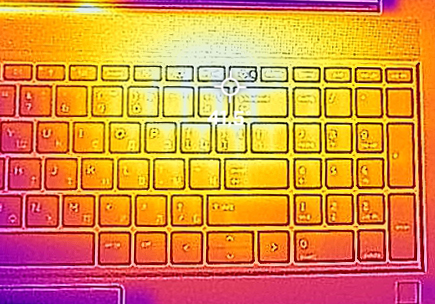
Verdict
 We find it peculiar that the GeForce MX570 inside this notebook runs at so low clock speeds, but still delivers an impressive gaming experience. Titles like CS:GO and DOTA2 are not a match for this otherwise low-power GPU.
We find it peculiar that the GeForce MX570 inside this notebook runs at so low clock speeds, but still delivers an impressive gaming experience. Titles like CS:GO and DOTA2 are not a match for this otherwise low-power GPU.
With that said, both the computational and the graphics performance are okay, which makes us think that you can only have good times with this device. There is a bit of a difference between the ProBook 450 G9, and the EliteBook 650 G9. For instance, the latter does feature a Thunderbolt 4 connector, while the former is “limited” to USB Type-C 3.2 (Gen. 2) with Power Delivery and DisplayPort functions.
HP ProBook 450 G9’s IPS panel has a Full HD resolution, comfortable viewing angles, and a good contrast ratio. It doesn’t use PWM for brightness adjustment, but unfortunately, it covers only 51% of the sRGB color gamut. Furthermore, we noticed that it has a very low gloss, which is great for outdoors use.
The battery life is also decent with 12 hours of Web browsing, or 8 hours and 30 minutes of video playback on a single charge. Keep in mind that our configuration was equipped with the 51.3Wh unit, and the smaller 42.75Wh package will last you for a shorter time.
Anyways, the spill-resistant keyboard is equally awesome in all configurations. If you want, you can pair the HD Web camera with an IR face recognition scanner. A fingerprint reader is also an option, while the privacy shutter is a must.
Not only that, but you get great upgradeability with two SODIMM slots for DDR4 RAM, and two M.2 PCIe x4 slots for storage. One of them, however, is also used for the WWAN card, should you need LTE connectivity.
At the end of the day, there is not much that we would want from this device. Better speakers and an SD card reader are definitely on the table and probably better power management, or cooling – whichever is limiting the GeForce MX570.
You can check the prices and configurations in our Specs System: https://laptopmedia.com/series/hp-probook-450-g9/
Pros
- Its keyboard is backlit, spill-resistant, and great for typing
- Optional fingerprint reader and IR face recognition
- Good contrast ratio and comfortable viewing angles (LG LGD071E)
- 2x SODIMM + optional two M.2 PCIe slots for storage
- Doesn’t use PWM (LG LGD071E)
- Wide port selection
- Great performance
- Good battery life
Cons
- Covers only 51% of sRGB (LG LGD071E)
- Lacks an SD card reader
- Low clocks on the GeForce MX570


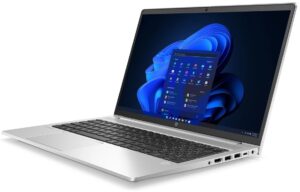
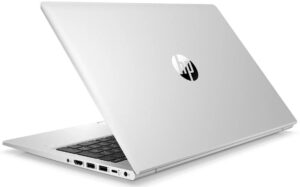
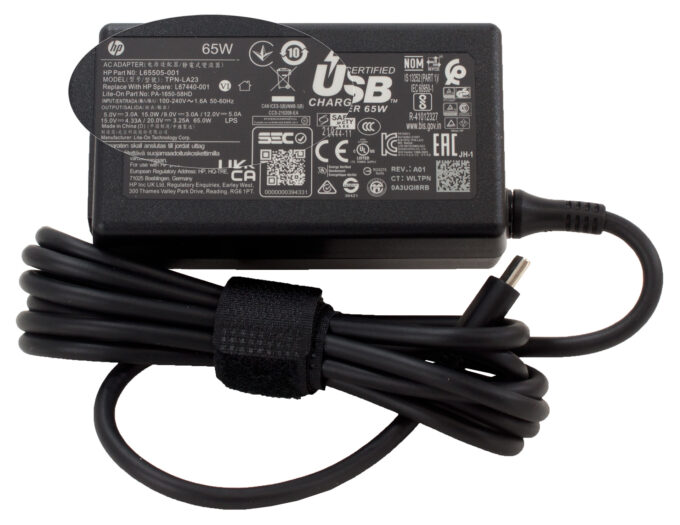


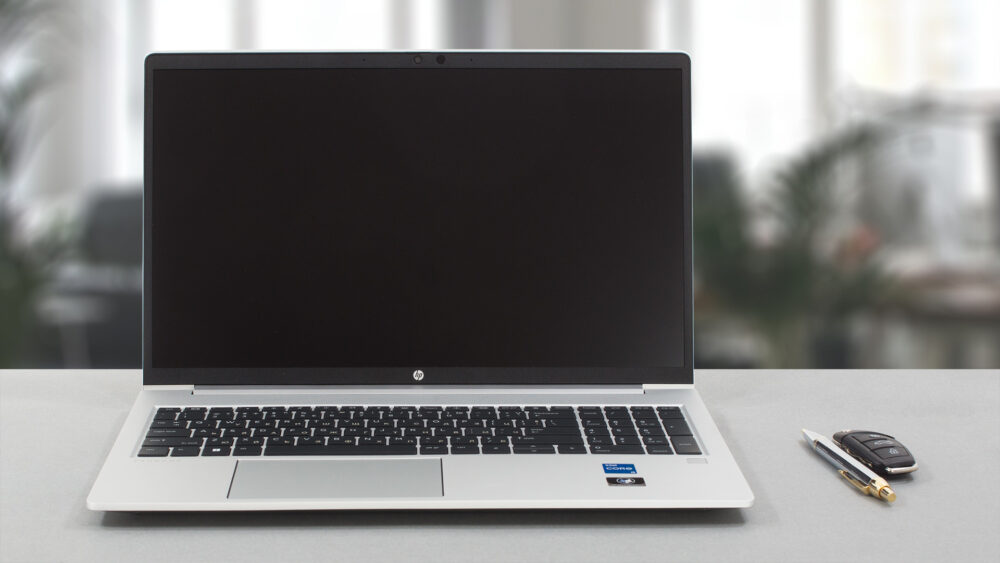
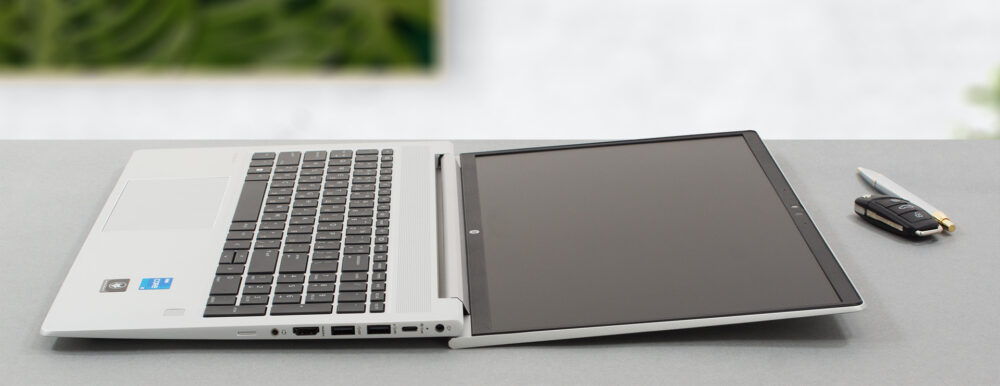
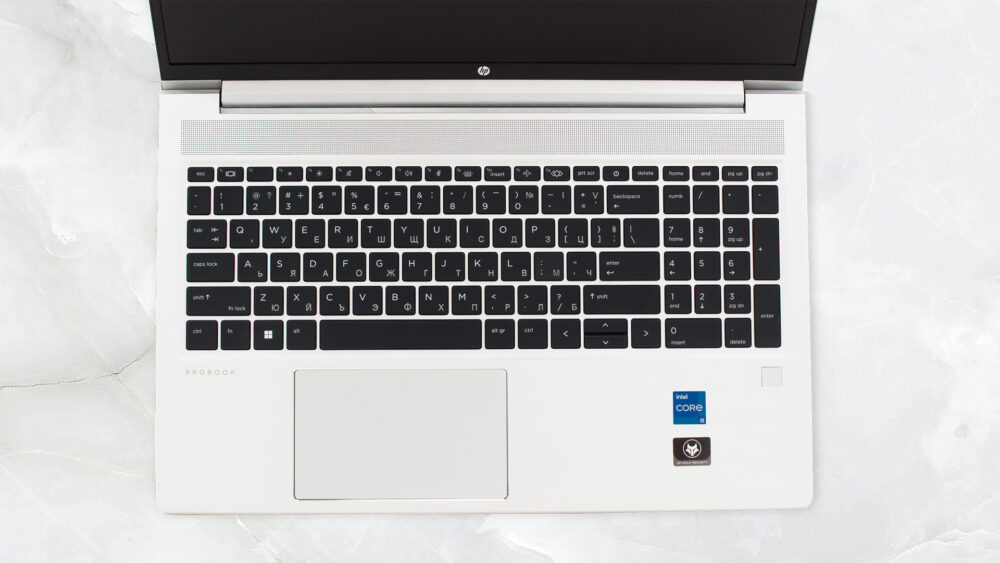
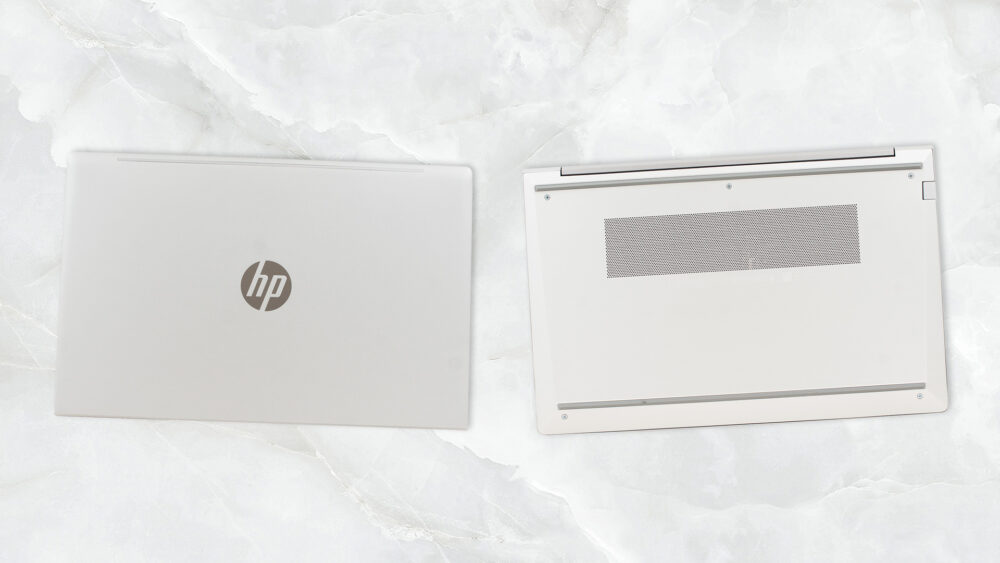


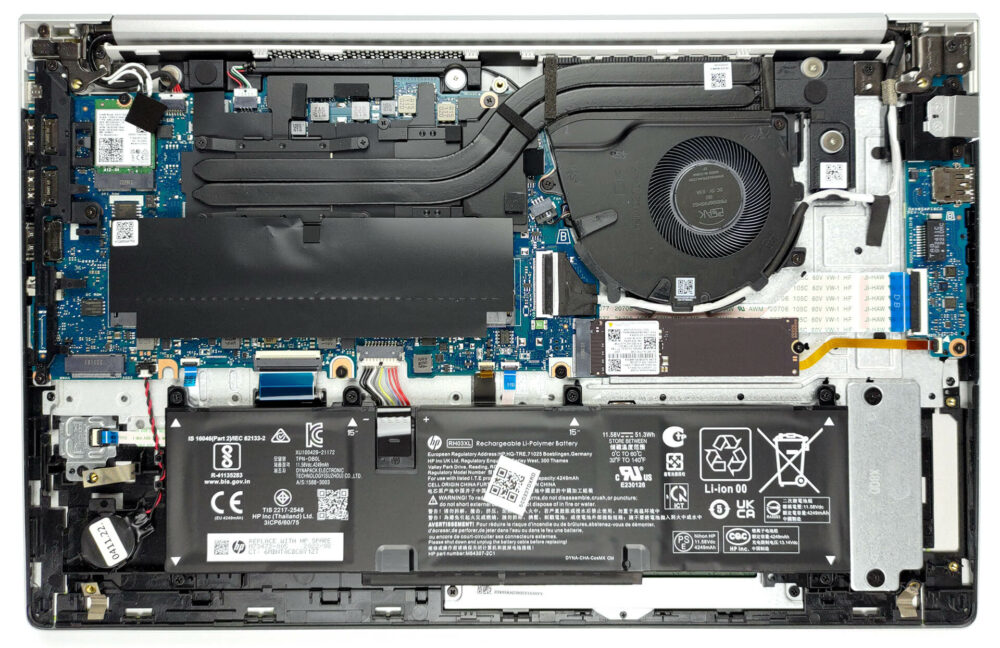
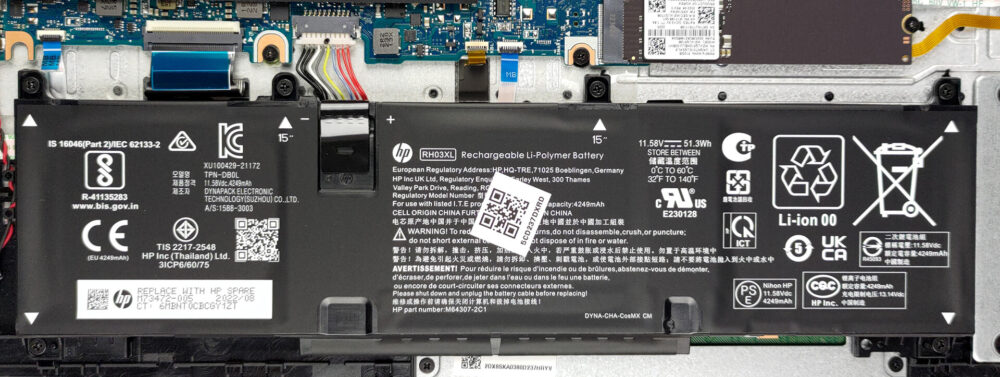
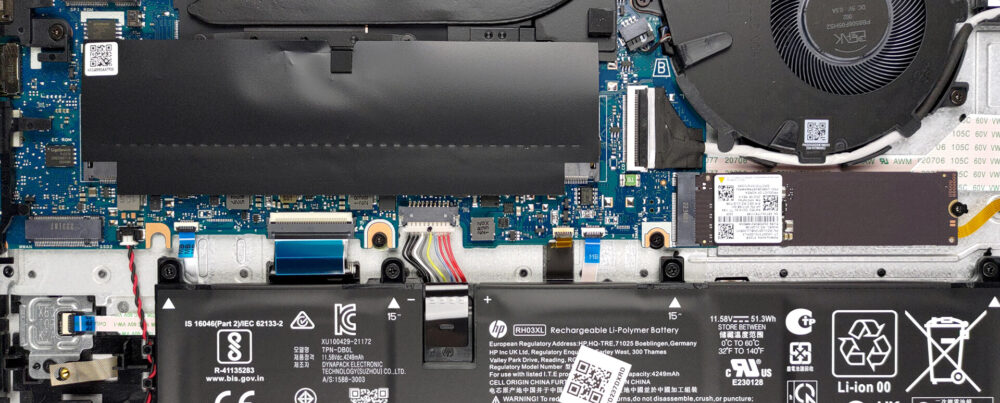
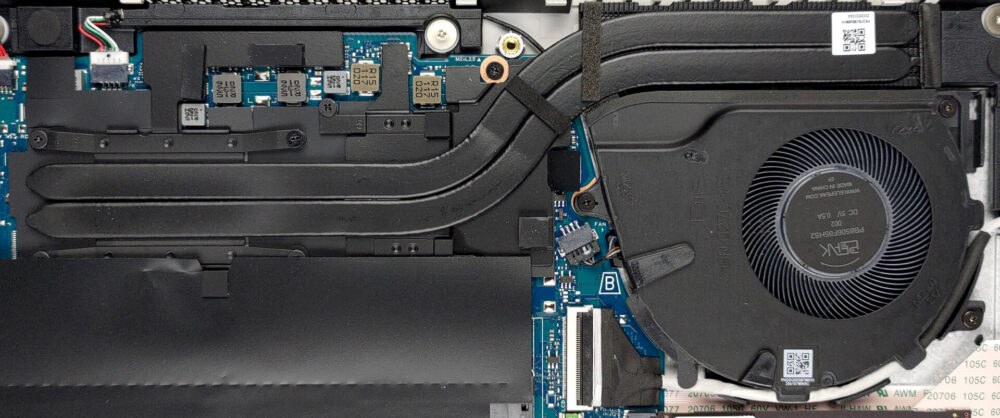

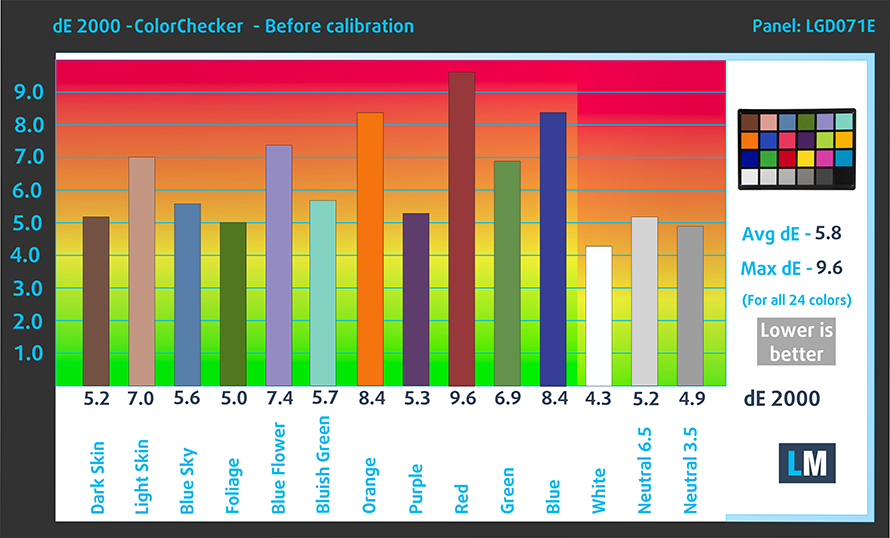
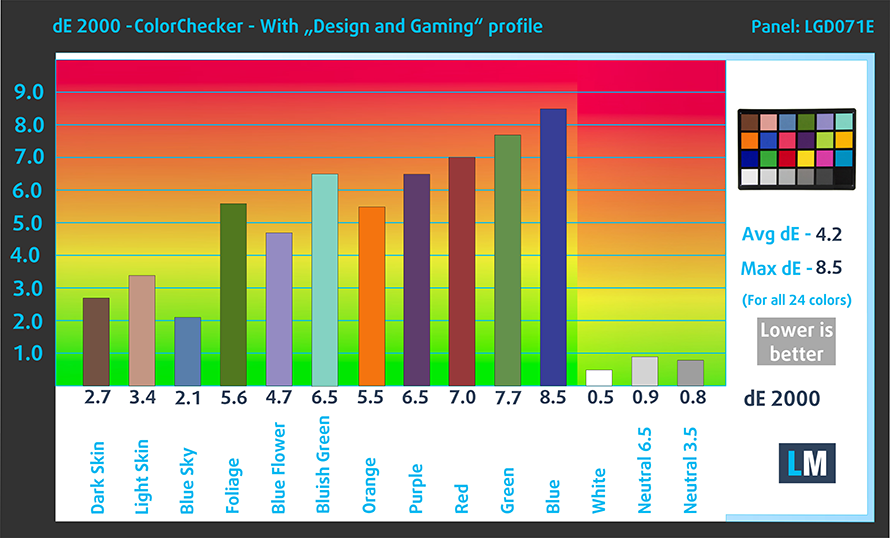

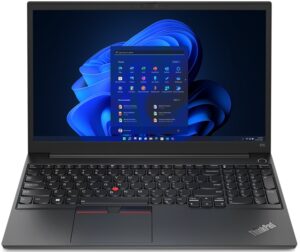








I bought an HP ProBook 450 G9 some nine months ago… At the price, the pitiful 16GB RAM it comes with is stingy of HP, as 16GB is next-to-useless these days. Most important aspects, IMO: 1) It is hysterical to call it ‘Pro-‘Book – it can barely handle any software and the CPU is persistently at 100%. 2) Already, one of the USB port connectors is coming loose – at the price this laptop has, that’s disgusting and a rip-off. 3) I can only describe it as expensive rubbish that HP should be ashamed of knowing they are ripping off… Read more »